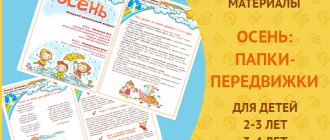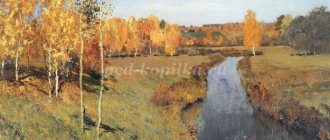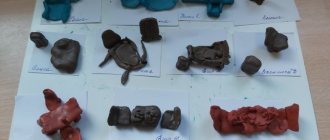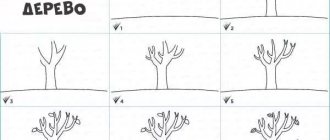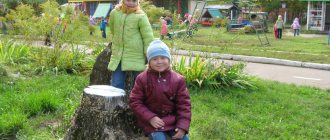GCD for children of the senior group “Golden Autumn”. Nature calendar
ECD for children of senior preschool age “Golden Autumn”. Filling out the nature calendar.
Program objectives: 1. Continue to develop knowledge about autumn, autumn phenomena; 2. Pay attention to changes in nature; 3. Develop the ability to select pictures for the nature calendar, correlating them with the natural features of autumn; 4. Develop observation skills; 5. Activate mental activity; 6. Help to remember the autumn months; 7. Foster interest and respect for nature. Required material: - nature calendar, illustrations for it. Progress of the lesson: Educator: Guys, what time of year is it now? Children: Autumn Teacher: How did you guess? Children's answers. Educator: What has changed with the arrival of autumn? Children's answers. Educator: Today we will fill out the nature calendar.
Educator: First, let's remember the autumn months. Name them. Children: September, October, November. Educator: What month is it now? Children: October Teacher: That's right! September is the first month of autumn. Then October and then November. Let's look at the pictures and determine where the previous month is. Children: September.
Children take the picture and attach it to the nature calendar. Educator: And now the real month is October
Children take a picture, explain why this particular picture is attached to the nature calendar. Educator: And the last month is... Children: November.
Children take a picture, explain why this particular picture is attached to the nature calendar. Educator: look at the pictures. All pictures show birch. What tree do you think we should put on the nature calendar and why?
Children show the desired picture and explain: This is a tree with yellow leaves, it is autumn, a tree with buds is spring, bare is winter. We need to place an autumn birch tree.
Educator: Now let's look out the window and determine what the weather is like outside? Children: it’s windy because the trees are swaying. Cloudy because the sky is gloomy. Children select the necessary pictures and attach them to the nature calendar. Educator: What autumn phenomena did you observe this morning? Children: Leaf fall Educator: Let us be autumn leaves today. I invite everyone to the group center
Physical exercise “Leaf fall” Educator: What phenomenon have we now depicted? Children: Leaf fall.
Children select the desired picture and attach it to the nature calendar. Educator: Well done! What other autumn phenomena do you know? Children: Frost, fog. Educator: What other changes occur in the fall? Children: It often rains and snows, the grass turns yellow and becomes dry
Children select the necessary pictures and attach them to the nature calendar. Educator: What happens to birds and animals with the arrival of autumn? Children: Birds fly away to warmer climes, animals prepare for winter.
Children select the necessary pictures and attach them to the nature calendar. Educator: how does people’s appearance change in the fall? Children: People change clothes for warmer ones
Children select the desired picture and attach it to the nature calendar. Educator: What happens to the sun? Children: The sun does not send direct rays and heats less
Children select the desired picture and attach it to the nature calendar.
Educator: Correct. Now our nature calendar is full, and we will promise to protect nature? Children: We promise! Using this GCD summary as a basis, you can use your nature calendar in the same way! Good luck to you!
We recommend watching:
Summary of a lesson on speech development in the senior group on the topic: Autumn GCD for the senior group with a presentation on the topic: Gifts of Autumn Summary of a lesson in the senior group on the museum program on the topic: Autumn Summary of a lesson in mathematics in the senior group for children with mental retardation. Journey to the autumn forest
Similar articles:
Lesson summary - traveling in kindergarten for the International Day for Older Persons
Entertainment “Visiting Autumn”. Senior group
introduce children to the calendar page for September, symbols; learn to draw icons, use stencils, carefully color the squares of the days of the week; develop an interest in observing nature.
Material:
calendar page for September, calendar page with symbols, white paper (for each child); stencils of icons, squares of days of the week, colored pencils.
Progress of the lesson
Part 1. The teacher arouses children's interest in autumn natural phenomena using poetry, riddles, and music. Then he introduces them to the “September” calendar page, draws attention to the lines, the cells of the days of the week, the weather, and the place for a drawing on the theme “Wildlife.” He says that today—Monday—observations of nature on the site will begin and that the results of observations should be sketched in the calendar using symbols (icons).
Part 2. Introducing children to icons. The teacher demonstrates the “Symbols” page, clarifies the sequence of days of the week, the color of each day, and examines with the children the icons indicating weather phenomena and animals.
To clarify the understanding of the symbolism of the icons, the teacher conducts game exercises with the children like: “I thought of a day of the week, which is indicated by blue (yellow or other) color. What day is it? Show it on your calendar." Or: “I wished for a sparrow. What icon does it represent? Show". And so on.
3rd part. Formation of practical skills in the depiction of icons. The teacher invites the children to use a stencil to draw 3-4 squares - “days of the week”, then paint over the contours in two ways - without a stencil and with it. Draws attention to the thoroughness of painting, specifies what day (by color) this or that child depicted.
Children practice drawing icons indicating weather phenomena, learn to draw a human figure, color this icon in accordance with the weather, and depict birds and insects.
Children draw new squares and learn to depict sunny or rainy weather in them, try to draw bird icons.
During the walk, the teacher organizes weather observation. Invites everyone to look at the sky and say what color it is, what is on it (clouds, clouds, sun), whether it is raining. Determines the weather based on the state of the sky (cloudy, sunny, cloudy, rainy). Then the children determine whether there is wind (they look for signs by which it can be detected). The teacher gives another definition of the weather: windy (quiet). Finally, temperature features of the weather are discussed. The teacher draws the children's attention to their clothing, its correspondence to the weather and season, and asks them to define the weather (warm, cool, very warm, a little cool, cold). To summarize, for example: today the weather is sunny, quiet, warm. The teacher invites the children to remember this definition in order to record the results of the observation in the nature calendar after the walk.
In the group, everyone gathers near the calendar, figuring out which icons should be used and where to mark the weather. The teacher helps those who want to draw icons and color in the Monday box.
Tuesday
When organizing observations, the teacher can use the technique of comparison: “Children, you, of course, remember what the weather was like yesterday and how we marked it on the calendar. I wonder if the weather is the same or different today? Look at the sky and tell me what it was like yesterday and what it is like today... That’s right, yesterday the sky was blue, clear, the weather was sunny, but today the sky is cloudy, whitish, the blue is not visible at all. We can say about this weather that it is cloudy. Now determine if there is wind and compare with yesterday’s weather.” Children look for and name signs of wind, compare the weather. The teacher summarizes: “Yes, there is a strong wind today, they say about this weather that it is windy. Now tell me whether it is warm or cool today and how you are dressed - the same as yesterday or differently. Maybe today your mothers dressed you warmer than yesterday?” The teacher helps the children find out what changes have occurred in their clothes. Gives a general definition of the weather: “Well, we found out: today the weather is cloudy, windy, cool. Remember this because we will be marking the weather on the calendar again.”
In the group, after the walk, the procedure for filling out the calendar is repeated: the teacher clarifies the day of the week with the children, helps them find the right cell on the calendar page, determine which icons should be used to mark today’s weather, and fill in the corresponding cells. Everyone looks at the calendar together and compares the weather on Monday and Tuesday using the icons.
Wednesday
In order to make it interesting for children and the teacher himself, a new technique is used in observing the weather - play. When getting the children together for a walk, the teacher suggests taking one of the dolls with them: “Children, your favorite bunny whispered to me that he would also like to go for a walk. Let's take him with us!"
Observation is carried out in the same way as in previous days (according to the same scheme). The children tell the story to the bunny, who has never been outside before and doesn’t know anything and doesn’t know how to determine the weather condition by the sky, wind, or clothes.
The teacher encourages children to make independent judgments and statements. The bunny is used for the same function when filling out the calendar. The technique will give a good result, and children will be involved in the situation of teaching the bunny only if the teacher plays his role, uttering remarks, questions, and performing simple actions on his behalf.”
Thursday
In an effort to increase the level of activity of children, the teacher uses a new technique: at the beginning of the walk, he gives everyone the task of observing the weather on their own, so that later in the group they can talk about it and fill out the calendar correctly.
During the walk, all children are observed to observe the vegetation of the site and its seasonal condition. The teacher carefully examines one of the trees with the preschoolers (then it will be sketched in the calendar), finding out what the tree is called, what color its leaves are, which leaves are more yellow or green, where the yellow leaves are located and where the green ones are, whether there are fallen leaves under the tree leaves and what color they are, where there are more leaves - on the tree or under it, does the tree look beautiful with multi-colored leaves. Then other trees and shrubs in the area are discussed and signs of autumn are looked for.
It is important that the teacher draws children’s attention to the beauty of autumn colors and encourages them to independently find beauty in nature, for example: “Children, let’s move away to look at the trees from afar. Admire them and tell me who likes which tree and why, that you noticed something beautiful.” You need to listen carefully to the children’s answers, and then say something like this: “I’ll also tell you about what I like. I admire the mountain ash every day. It is very elegant, with clusters of bright berries and slightly reddened leaves, carved like lace. The birch tree is beautiful in a different way: its small leaves began to turn yellow on the top. It’s like putting on an autumn hat! But the lower branches still hang in green braids. And a Russian beauty stands on a white leg in a green sundress and a yellow hat!”
Then the vegetation cover of the earth is examined and its seasonal state is determined. We need to draw the children's attention to the fact that the grass is still green, the fallen leaves stand out brightly on it, they have not yet withered and have a pure yellow color, which is a lot of flowering plants. Let the children look and name them.
In the group, all the children are given a lesson in art activities - each child draws a tree, which was examined in particular detail, and the cover of the earth. The size of the paper on which children draw corresponds to the size of the “Wildlife” column in the calendar. The teacher instructs the children to draw as accurately and believably as possible what they observed - the most similar drawing will be placed on the calendar. The drawing technique and materials can be any, the main thing is the similarity in the rendering of natural objects. At the end of the lesson, everyone looks at the drawings and together chooses the most successful one. To clarify the accuracy of the image, the drawing can be compared (from a room window or on a walk) with nature. The teacher, in the presence of the children, corrects the drawing and places it on the calendar.
Friday
Having gone out for a walk with the children, the teacher gives them the task of finding out what animals are found during this period of September (early autumn), i.e. what birds can be seen, insects, worms, snails. Asks children to observe animals - to clarify in what place they were found, what they are doing (for example, in relation to insects - are they actively moving or frozen). A small group of children (3-4 people) is assigned to observe the weather.
At the end of the walk, the teacher discusses the children’s independent observations with the whole group - finds out what and where animals they met, and what these animals did. Praises those who did not forget to complete the task. Then he offers to listen to the children who were asked to observe the weather. The children tell the story, the teacher helps them maintain the sequence, and involves everyone else in assessing the correctness of the observations and the story. In conclusion he makes a generalization: “Today is Friday. You and I watched the weather for five days in a row. It was different every day. Today, as the guys correctly noted, the weather is cloudy, windy, and cool. This kind of weather often happens in the fall.”
In the group, those who observed the weather mark it on the calendar. The teacher helps them do everything right. He asks the rest of the children to depict in the “Wildlife” column the animals they found on the site.
In the evening, everyone looks at the calendar page together. It turns out that there are two days left until the end of the week - Saturday and Sunday. The teacher invites the children to independently observe the weather these days and talk about it on Monday.

